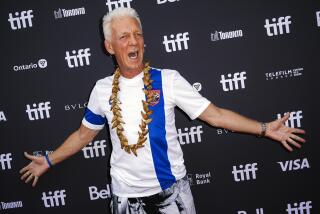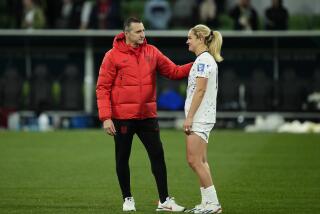World Cup ’94 : WORLD CUP USA ’94 / GROUP F PREVIEW : Orange Crush? : The Netherlands’ Re-Emergence Tied to Meshing of Old and New
- Share via
Ask any soccer fan to name the five greatest players ever and, chances are, Johan Cruyff would be high on the list.
Voted European player of the year in 1971, 1973 and 1974, Cruyff was a player of sublime skills, a forward who ranked alongside Pele, Diego Maradona, Franz Beckenbauer and George Best as the greatest of their generation.
Cruyff inspired the Dutch national team in the 1970s, the player whose sparkling talent led his country to the 1974 World Cup final, which the Netherlands lost to West Germany, 2-1, in Munich.
Four years later, the Dutch, still under the leadership of Coach Rinus Michels but now without Cruyff, again reached the final. This time, they lost to Argentina, 3-1, in Buenos Aires.
That marked the end of an era. The brilliant Dutch team of the ‘70s passed into history. The era of “Clockwork Orange” and “Total Football” was over.
If the Dutch could not win the World Cup with players such as Cruyff, Johan Neeskens, Johnny Rep and Ruud Krol in their ranks, they never would win it. At least that was the theory.
Now, flash forward to the 1980s. The great Dutch clubs of Ajax Amsterdam, Feyenoord and PSV Eindhoven again had produced a collection of superb players. Holland’s new stars were Marco Van Basten, Ruud Gullit, Frank Rijkaard and Ronald Koeman.
Like their predecessors, they dominated the European scene. Gullit was selected European player of the year in 1987. Van Basten won the same honor in 1988, 1989 and 1992.
Together, and still under Michels’ guidance, they achieved the Netherlands’ greatest triumph by winning the 1988 European Championship in Germany, a feat that sparked a national celebration.
By 1992, however, the Dutch team was beginning to fade. Injuries and time had taken their toll. At that year’s European Championship, in Sweden, the stars of the ‘80s burned brightly one last time in a thrilling 3-1 quarterfinal victory over Germany, but the Dutch then lost the semifinal on penalty kicks to eventual champion Denmark.
Van Basten, of all people, saw his decisive kick saved. Another era of Dutch soccer had ended.
Now, flash forward again. It is 1994. The Dutch team has qualified for the World Cup in the United States. And who are the names being talked about? Cruyff? Van Basten? Gullit? Michels?
How could this be?
Soccer has come full circle. Twenty years after losing the World Cup final in Germany, the Dutch again are among the favorites to win the 1994 title.
They would have been favored even more had it not been for four factors.
After agreeing to take over as coach of the national team if it qualified for the finals, Cruyff no longer will be involved. He and the Dutch federation failed to see eye-to-eye on his financial and other demands.
Some commentators in Holland were astounded and angered by Cruyff’s stance, which they considered arrogant.
The Barcelona coach’s demands allegedly included a 10% share of the Dutch federation’s profits from the World Cup, the right to wear his own brand of sportswear (and not that of the Dutch team’s sponsor) and the refusal to have his photograph used commercially as part of the team.
With Cruyff out of the picture, the Dutch federation gave the World Cup coaching job to Dick Advocaat, who had successfully steered Holland into the finals. Advocaat has something else in his favor--experience in the United States. He played for the Chicago Sting of the defunct North American Soccer League.
But will Advocaat be able to motivate the team as well as Cruyff? Indeed, will some of the stars even play well for him?
“Making comparisons is all part and parcel of the game,” Advocaat said, “but I can live with that.
“I have complete confidence that we can get excellent results. We have the players to do that.”
But Gullit, long a Cruyff supporter, refused to play for Advocaat in the qualifying matches and his participation in the World Cup was in doubt. Then, after enjoying a tremendous season with Sampdoria in Italy, the dreadlocked Dutchman, now 31, again became part of the coach’s plans.
But only briefly. After appearing for the Netherlands in a well-earned victory over Scotland and playing well, Gullit inexplicably quit. This time, it was for good. He gave no explanation.
In a surprise move, Advocaat then turned to 29-year-old Van Basten, who has been struggling to recover from ankle surgery for more than a year.
Van Basten at first agreed to replace Gullit. Then, under pressure from AC Milan, his club team, he changed his mind and said he would not accept Advocaat’s offer.
Turmoil in the Dutch squad is par for the course, it seems.
The fourth factor that might hurt Dutch chances this summer is the age of some key players. Defender Koeman, for example, is 30 and has lost a step or two. But his ability to win a match with a single wicked, curving free kick makes him indispensable. Koeman, who plays for Cruyff at Barcelona, is said to have the most powerful shot in soccer.
Then there is Rijkaard, 29, who is playing as well as ever, having left AC Milan this season to return to Ajax Amsterdam. Midfielder Jan Wouters, at 33, is another veteran who has seen better days but is still playing well.
And a new generation of Dutch stars is beginning to emerge. Striker Dennis Bergkamp is regarded as one of the finest forwards in the world and a potential World Cup star. Others who could leap to prominence this summer include forward Peter van Vossen, Bryan Roy, Aron Winter and Marc Overmars and defender Ulrich Van Goebbel.
It is the mark of the Dutch team’s resilience that only a couple of days after the Gullit bombshell it trounced Hungary, 7-1, as if to emphasize that all was not lost.
So what are Holland’s prospects?
If Koeman and Rijkaard can shine one last time, if Advocaat can successfully blend yesterday’s stars with the stars of tomorrow, then the Netherlands must be considered a serious candidate to win the World Cup.
The Dutch task in the first round is not an especially difficult one. Holland has been grouped with its European neighbor, Belgium, as well as Saudi Arabia and Morocco.
In an odd twist, Saudi Arabia was formerly coached by Leo Beenhakker, a former coach of the Netherlands. Beenhakker was fired and replaced by Argentina’s Jorge Solari. The Dutch should make the second round with ease, and their progress after that will depend on which teams they meet on the road to the Rose Bowl.
And if they go all the way, they will take their fans with them and the Pasadena stadium will be turned into a sea of orange. Dutch fans are the most colorful, if not bizarre, in the world, with a passion for outrageous costumes.
But while the cameras focus on the painted faces in the crowd, soccer fans will be looking for the patterns being woven on the field.
And what if Holland and the United States should meet? What an odd coincidence that would be.
The U.S. federation recently named Rinus Michels as its director of coaching. And Michels used to coach the L.A. Aztecs, who used to play in the Rose Bowl and had Cruyff as their star player.
A Netherlands-United States final in Pasadena is an unlikely scenario, but it would make the circle complete.
More to Read
Go beyond the scoreboard
Get the latest on L.A.'s teams in the daily Sports Report newsletter.
You may occasionally receive promotional content from the Los Angeles Times.






